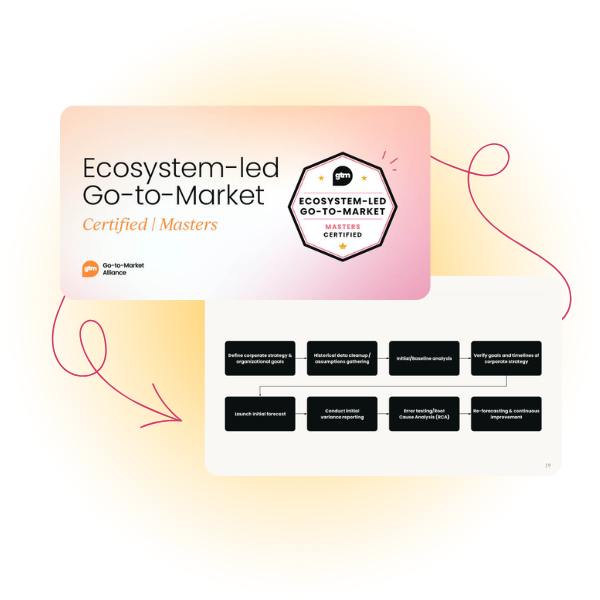Here's potentially an all-too-familiar story.
You've poured your heart and soul into your new product. It's the perfect solution, ready to disrupt the industry. But launching it feels like navigating a maze – dead ends, confusing directions, and the constant question of whether you're on the right track.
This is where the magic of partnerships comes in.
The right partner can be the missing piece in your go-to-market (GTM) strategy.
By the end of this article, I hope you’ll understand how partnerships can amplify your GTM efforts. You will gain insight into leveraging partnerships to navigate challenging markets and get you in front of the right audience.

We'll start with this crucial question: "At which stage in the GTM cycle should you start looking for partners?"
Before answering this, however, let’s look at an important team that could exponentially help you with your GTM efforts but is often overlooked.

Your pre-sales team
The pre-sales team is a critical component of your go-to-market strategy. These are your frontline soldiers who navigate the world of cold outreach, connecting with potential clients and validating your assumptions about the market.
These are the folks who navigate the treacherous world of cold outreach, connecting with potential clients and validating your assumptions about the market.
But remember, market assumptions can evolve. So have your pre-sales team act as your market research arm, using cold outreach as a data-gathering tool.
Here's how:
- Before you do anything, it's a good idea to get your fundamentals straight (Ideal Customer Profile, buyer personas, value propositions, etc.) This way you can equip your pre-sales team with targeted messaging that resonates with your ideal customer profile. Work with them to craft emails, cold calls, and other outreach materials that speak directly to your target audience.

- Is your pre-sales team trained to analyze the reasons behind negative responses? Are you targeting the wrong audience? Does your value proposition need tweaking? Use this feedback to refine your GTM strategy. And don't be discouraged by rejections! Every "no" is a valuable piece of data.
- Every interaction with a potential customer is a goldmine of information. The pre-sales team should meticulously track their outreach efforts, including the number of contacts made, responses received, and most importantly, the reasons behind those responses. This data becomes the compass that guides your GTM direction.
Now to answer the question, this is the stage where you start looking for partners that can help you build a solid foundation for your GTM strategy. Seek complementary organizations that provide the expertise you’re looking for, along with the synergy required to build a high-functioning GTM engine.
And if you're thinking, "Well, that sounds ideal, but how do we do that?"
Well, here's how.
Choosing the right partner for your business
Think of your ideal partner as your co-pilot – someone who complements your strengths, fills in your knowledge gaps, and shares your vision for conquering the market.
Here are some key aspects to consider when selecting your partnership dream team:
- Shared values and vision: Imagine building a plane with someone who believes in hot air balloons. It wouldn't exactly soar, would it? Your partner needs to resonate with your core values and clearly understand where you want to take the business. Are you passionate about social impact? Find a partner who shares that drive.
- Complementary skillsets: Seek partnerships that allow you to focus on your expertise without worrying about anything else. Say you're a tech wiz but a bit off the mark when it comes to marketing or sales. Then, look for a partner who thrives in those areas where you don’t. This creates a powerful combination.
- Market reach and reputation: Partnerships are all about expanding your reach. Does your potential partner have a strong foothold in your target market? Do they have a stellar reputation that rubs off on you by association? Do they come with a network of potential relationships you could benefit from, and vice-versa? Do they cater to the same or similar industries as you do? These are important questions to ask before going ahead with a decision.
- Collaborative culture: Building a successful partnership requires open communication and a willingness to work together. Assess the partner's communication style and ensure it aligns with yours. This is critical because smooth information flow prevents misunderstandings and delays, leading to a united front for tackling challenges and achieving shared goals.

How partnerships in the pre-sales stage can empower your strategy
So, you might be wondering how your pre-sales team can leverage partnerships for improved processes. Well, your pre-sales partners can help your internal teams supercharge your outreach efforts through
- Combined market research,
- Co-crafted sales pitches,
- And seamless collaboration.
Let’s look at each point in more detail.
Combined market research
This strategy is all about deep diving into your existing customer data and your assumption of the Ideal Customer Profile (ICP).
Partner with your pre-sales team to analyze your current client base. Together, you can identify key characteristics and pain points that define your ideal customer profile (ICP). Look for patterns in demographics, firmographics (company size, industry), and buying behaviors.
This ICP will become the compass guiding your GTM strategy. Leverage marketing tools to identify look-alike audiences – new prospects who share the same characteristics as your successful clients.
Co-crafted sales pitches
Gone are the days of one-size-fits-all outreach.
Work with your partners to tailor messages that resonate with your look-alike audience. Analyze their online behavior and identify the challenges they face. Use this information to craft targeted messages that address their specific pain points and highlight how your product or service offers a solution.
By personalizing your outreach based on look-alike data, you'll increase engagement and conversion rates.
Seamless collaboration
Remember, crafting the perfect message is an ongoing process.
Team up with your pre-sales team to A/B test different versions of your outreach materials and messaging. This allows you to see which messages resonate best with your look-alike audience. Analyze the results together and refine your approach based on the data.
This cycle of testing, analyzing, and refining ensures your GTM strategy stays laser-focused on attracting high-quality leads that convert into customers.

Remember: It's a partnership, not a power struggle
As you embark on this collaborative journey with your partners, remember – it is never a zero-sum game. Everyone wins something and this only happens when you don’t treat it as a power struggle.
Success hinges on open communication, mutual respect, and a willingness to work together. Celebrate wins as a team, and address challenges collaboratively. By fostering a strong partnership environment, you empower your partner and yourself to become superstars and in turn propel your GTM strategy to new heights.
Forge industry alliances and become unbeatable
Looking for the full, actionable low-down on building partnership strategies?
Sign up to Ecosystem Go-to-Market: Masters and Reach new audiences, amplify your messaging, and finally sell at scale when you learn how to leverage strategic partnerships the right way.







